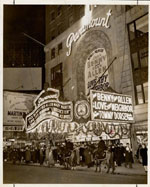The New York
Public Library for the Performing Arts > Vaudeville
Nation
Prologs for the Picture Palaces

Paramount Theater, NY,
exterior and marquee, 1929

Act curtain by Lee Lash
Studio for the celebration
of Edward
Bowes' birthday
at the Capitol Theater,
which he managed.
Prologs were the short vaudeville shows developed for the
late silent film era, 1926 - 1929. Also called Units and
Presentations, they were run on the film distribution circuits
that had been cobbled together by the film studios and theater
owners. The theaters were ornate and elaborate, with designs
based on Oriental, Egyptian, or Mayan motifs. The gallery
is filled with photographs of the lobbies, lounges, prosceniums
and audience spaces designed by the architectural firm of
Rapp for the Balaban & Katz chain, out of Chicago. In
the 1930s, the circuits commissioned Art Deco picture palaces,
most notably including Radio City Music Hall.
Unlike pure vaudeville, Prologs frequently had a spokesman
or emcee. It could be the bandleader, as in the Fanchon & Marco
circuit shows, or a radio personality. Major Edward Bowes
connected the radio audience with The Capitol Theater.
The
Prolog studios had unified production teams, creating a consistent
production, choreography, design, and orchestration
that traveled as a unit. The producers set the house styles – Leon
Leonidoff of the Roxy and Radio City Music Hall often featured
large themed productions numbers, Chester Hale loved jazz,
Fanchon promoted adagio dance teams and small precision teams,
and J. A. Partington of Paramount-Publix liked eccentric
dance on Art Deco scenery.
Related Images